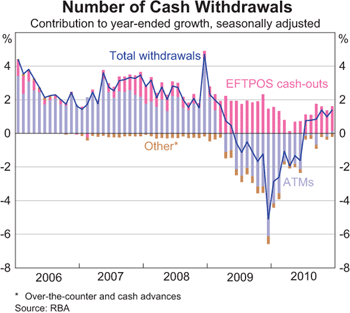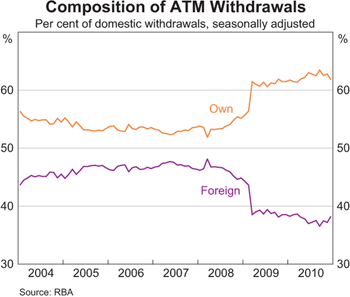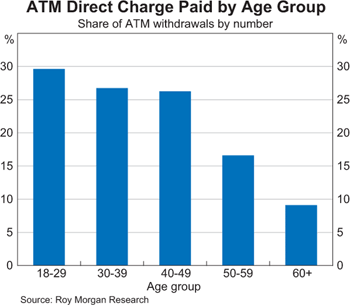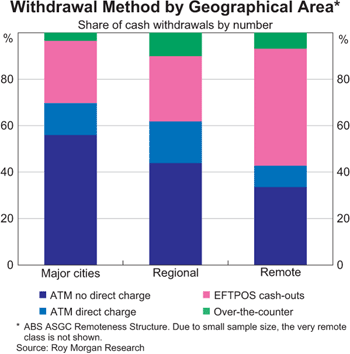The ATM Reforms – New Evidence from Survey and Market Data
Darren Flood, Jennifer Hancock and Kylie Smith*
Following the introduction of direct charging in March 2009, ATM pricing has become more transparent and flexible. Cardholders continue to respond to the clearer price signals by changing their cash withdrawal behaviour to avoid paying direct charges, and newly available data indicate that behaviour varies across age groups and geographic locations. For the small proportion of transactions that do incur a direct charge, flexibility in ATM pricing has led to a distinct pattern in these charges across different types of ATM locations. Variations in business models between ATM owners mean that most consumers have access to a large number of ATMs on which they pay no direct charge, while it remains possible for ATMs to be profitably deployed in high-cost or low-volume locations.
Introduction
The Bank is continuing to closely monitor the move to direct charging at Automated Teller Machines (ATMs) that was implemented in March 2009. An initial discussion of the effect of this reform was provided in June last year (Filipovski and Flood 2010). A key finding at that time was that consumer behaviour had changed markedly as consumers sought to avoid paying ATM direct charges by, among other things, increasing their use of EFTPOS facilities and ATMs provided free of charge by their own financial institutions to obtain cash.[1] In total, these changes were estimated to have saved consumers around $120 million in withdrawal fees in the first year of the new arrangements. Another finding of this early analysis was that the availability of ATMs had increased, including in rural and regional areas.
As well as providing an update of broad trends in consumer behaviour, this article provides additional information on the effects of the reforms which is drawn from new data sources. These sources include information that the Bank has collected directly from ATM owners on pricing and the results of a consumer survey, which sheds more light on consumer behaviour. Also, a new market study on ATM deployment and costs (Edgar, Dunn & Company 2010) helps to provide a more complete picture of the effect of the reforms on competition among different types of ATM owners.[2] All of the available information continues to suggest that consumers are responding to the pricing signals inherent in direct charging, and ATM owners are responding by increasing the availability of ATMs.
The Response of Cardholders to Direct Charging
Since the implementation of the ATM reforms, there have been significant shifts in consumers' behaviour. These shifts have been observed in data on total cash withdrawals that the Bank receives from most financial institutions and some other payment industry participants as part of a regular collection. The total number of cash withdrawals from any source by consumers contracted sharply following the introduction of the reforms, driven largely by reduced ATM use (Graph 1).[3] This was partially offset by a sharp increase in the use of EFTPOS to obtain cash, which is typically free of charge to customers. Following consumers' initial adjustment to the reforms, ATM use has levelled out, while continued growth in EFTPOS cash-outs has underpinned modest growth in cash withdrawals overall.
Graph 1
The marked shift towards consumers using their own institutions' ATMs observed in the year following the reforms has been maintained and, if anything, has strengthened a little (Graph 2). There has also been an increase in the number of agreements between card issuers and ATM owners to provide free transactions to cardholders.[4]
Graph 2
To enhance the understanding of how individual consumers pay for goods and services, including their cash withdrawal behaviour, the Bank commissioned Roy Morgan Research to conduct a survey of payment patterns in late 2010. The 1,241 individuals participating in the survey were asked to record details of every cash withdrawal they made during a week, including the method used to withdraw the cash, the amount of cash obtained, and whether they paid a direct charge at an ATM. According to the survey, 23 per cent of ATM withdrawals incurred a direct charge during the week of the study.[5]
One issue raised during public consultation prior to the implementation of the reforms was that certain groups of consumers – for example older people – may be less willing or able to travel to seek out an ATM provided by their own financial institution and therefore are more likely to pay a fee. The survey data suggest, however, that younger consumers are much more likely to pay direct charges than older consumers (Graph 3). This is likely to reflect a variety of factors, such as different preferences regarding the use of their time and the locations of their cash withdrawals, with older consumers possibly more likely to withdraw cash as part of a regular spending pattern.
Graph 3
Another issue often raised is that people in non-metropolitan areas are more likely to pay ATM charges than those in metropolitan areas because they have more limited access to ATMs provided by their own institution. The survey results confirm this; on average, people in regional areas pay a direct charge on a larger proportion of their ATM withdrawals (29 per cent) than those in major cities (20 per cent, Graph 4).[6] Direct-charged ATM withdrawals also make up a slightly higher share of their cash withdrawals from all sources (18 per cent), compared with those living in major cities (14 per cent). However, the situation is quite different in areas classified as ‘remote’, where direct-charged ATM withdrawals make up only 9 per cent of cash withdrawals from all sources – the lowest of any of the location classifications that can be analysed from our survey data. Instead, use of EFTPOS cash-outs in these areas tends to be much higher than in major cities. Hence, it appears that most people in remote areas can still access cash in a way that avoids making direct-charged cash withdrawals.
Graph 4
It is worth noting that residents of areas classified as remote may still have access to multiple ATMs and other means of cash withdrawal. The consumer survey does not provide sufficient data to analyse ‘very remote’ locations, where people may have access to one machine at best. In these locations, ATMs are generally owned by independent providers, leaving consumers with no option but to pay direct charges.
As part of the ATM reform package, consumers now have the opportunity to cancel an ATM transaction without cost if they do not wish to pay the direct charge displayed. However, data on the extent to which cardholders have taken this opportunity have not previously been readily available. To address this issue, the survey specifically asked consumers about their reactions when faced with a direct charge. Around 10 per cent of respondents indicated that they had planned to make an ATM cash withdrawal in the past month but cancelled the transaction because the ATM owner charged a fee. This willingness to cancel transactions confirms that cardholders are responding to the charges and suggests there is some scope for ATM owners to attract foreign withdrawals by lowering their direct charges.
Around half of consumers reported completing an ATM withdrawal knowing that they would incur a direct charge. Of those, around 60 per cent indicated that their main reason for doing so was that it was the only ATM available (Graph 5). Nearly one-quarter indicated that they paid a direct charge because it was too far to the nearest ATM of their own financial institution. This group effectively made a judgement that the cost of going to the nearest ‘own’ ATM exceeded the direct charge. Around 10 per cent of consumers indicated that they did not know the location of their own institution's nearest ATM.
Graph 5
Direct Charges and Deployment
While the majority of ATM transactions are undertaken without consumers incurring a direct charge, in those cases where people do pay charges, the Bank has closely monitored their level by collecting detailed data from ATM owners. The most recent data indicate that there has been a small increase in the average direct charge on withdrawals since the previous collection in May last year (Table 1). The average direct charge for a withdrawal is now $2.04, up 5 cents since May 2010, despite some increases and reductions in direct charges at individual ATMs. The increase in the average direct charge partly reflects changes in the composition of ATMs deployed, with more ATMs installed in higher-cost locations or by ATM owners who charge higher prices. Around 17 per cent of ATMs now charge more than $2.00 for a foreign withdrawal, compared with 5 per cent in May 2010.
| May 2010 | December 2010 | |
|---|---|---|
| Source: RBA | ||
| $1.00 or less | <0.1 | 0.3 |
| $1.01–$1.50 | 6.5 | 6.0 |
| $1.51–$2.00 | 88.3 | 77.0 |
| $2.01–$2.50 | 5.1 | 16.3 |
| More than $2.50 | 0.1 | 0.4 |
| Average | $1.99 | $2.04 |
The broad trend has been similar for balance enquiries, with the proportion of ATMs charging more than $1.50 increasing by around 5 percentage points since May 2010 (Table 2). However, it appears that many consumers are not prepared to pay this fee. Data from Edgar, Dunn & Company (2010) indicate that balance enquiries make up around 23 per cent of domestic transactions at ATMs owned by financial institutions, compared with only 6 per cent for independent ATMs. This reflects the fact that most transactions at ATMs owned by financial institutions are made by customers of that institution and therefore do not incur a direct charge, while almost all transactions at independently owned ATMs incur a direct charge.
| May 2010 | December 2010 | |
|---|---|---|
| Source: RBA | ||
| $0.50 or less | 7.6 | 6.7 |
| $0.51–$1.00 | 12.1 | 7.8 |
| $1.01–$1.50 | 0.2 | 0.4 |
| $1.51–$2.00 | 78.5 | 83.4 |
| More than $2.00 | 1.6 | 1.7 |
| Average | $1.76 | $1.82 |
There is a distinct pattern in direct charges across different types of ATM locations (Table 3). Direct charges tend to be higher in licensed venues than other locations, followed next by retail premises. These appear to be locations where there are no competing ATM providers on site and customers are willing to pay for the convenience of not having to leave the store or venue. These locations are more likely to be served by an independent ATM, with a substantial portion of the direct charge revenue being shared with the owner of the premises. The average direct charge at independent ATMs is higher than at financial institution ATMs – $2.15 for withdrawals and $1.96 for balance enquiries, compared with $1.94 and $1.68, respectively, for financial institutions.
| ATMs | Withdrawal | Balance enquiry | |||||
|---|---|---|---|---|---|---|---|
| Per cent | Average | Maximum | Average | Maximum | |||
|
(a) For example, pubs
and clubs Source: RBA |
|||||||
| Retail premises | 31.5 | $2.08 | $3.50 | $1.84 | $2.85 | ||
| Licensed venue(a) | 23.5 | $2.15 | $4.00 | $1.93 | $2.85 | ||
| Branch | 20.6 | $1.94 | $2.50 | $1.76 | $2.00 | ||
| Shopping centre | 15.1 | $1.96 | $2.50 | $1.73 | $2.00 | ||
| Street | 5.7 | $1.97 | $2.50 | $1.76 | $2.50 | ||
| Other | 3.6 | $2.04 | $5.00 | $1.69 | $2.50 | ||
ATMs in the branches of financial institutions offer the lowest direct charge for foreign withdrawals, on average, while charges in shopping centres and on-street locations are also relatively low. The highest direct charge that the Bank is aware of in any location is $5.00 for a cash withdrawal at a specialised venue.
There is also some variation in direct charges according to whether ATMs are located in cities, regional areas or remote areas (Table 4). Direct charges on withdrawals are on average around 13 cents higher in very remote locations than in major cities. In large part this reflects the fact that a higher proportion of ATMs in very remote locations are provided by independent ATM owners who have relatively high direct charges on average, rather than ATM owners applying higher direct charges in remote areas than in major cities. Independent owners' operations appear to be well suited to servicing locations where the cost of installing and maintaining ATMs may be relatively high, in part because for an independent owner almost all transactions are direct charged. It is worth noting, however, that transaction volumes may also be relatively high in some remote locations.
| Withdrawal | Balance enquiry | ||||
|---|---|---|---|---|---|
| Average | Maximum | Average | Maximum | ||
|
(a) ABS ASGC
Remoteness Structure Source: RBA |
|||||
| Major cities | $2.03 | $5.00 | $1.80 | $2.85 | |
| Regional | $2.06 | $4.00 | $1.85 | $2.85 | |
| Remote | $2.09 | $2.85 | $1.91 | $2.85 | |
| Very remote | $2.16 | $3.00 | $1.91 | $2.85 | |
In general, the move to direct charging has made deploying ATMs in costlier locations more viable and has thereby increased the availability of ATMs. The number of ATMs now stands at around 29,500, up from around 27,000 in the year prior to the reforms.[7] Growth has been consistent across metropolitan and non-metropolitan areas, with 42 per cent of ATMs located outside metropolitan areas.[8] The installation rate for ATMs in remote and very remote communities has increased by over 50 per cent between 2008 and 2010.[9]
ATM Costs
The business model for ATMs varies greatly between financial institutions and independent providers and this is reflected in the average cost of providing each ATM transaction. In particular, transaction flows through ATMs owned by financial institutions are significantly different to those through independently owned ATMs. According to Edgar, Dunn & Company (2010), the average number of transactions per month at an independent ATM is around 1,200, compared with just over 6,500 transactions at an ATM owned by a large bank and over 4,000 at an ATM owned by a smaller financial institution. As a result, while independent owners account for just over half of the ATMs in Australia, those ATMs account for only 16 per cent of ATM transactions.
A direct corollary of this is that the average cost per transaction for independent owners is often significantly higher than for financial institutions, because overheads are spread across fewer transactions. Edgar, Dunn & Company (2010) estimates costs per transaction at 54 cents for large banks, compared with $1.12 for independent owners.
In addition to relative transaction volumes, differences in per-transaction costs between financial institutions and independent owners also reflect deployment strategies. While over 40 per cent of financial institutions' ATMs are located in branches, almost all independent ATMs are located off-premises. To secure ATM locations, ATM owners usually have to pay some form of rent or rebate (site costs) to the owner of the premises. On average, payments for each non-branch ATM site are more than double those for branch ATM sites. On a per-transaction basis this differential is even larger as the average volume of transactions at non-branch ATMs is less than half that at branch ATMs. Not only are site costs for non-branch ATMs generally higher but they have also been rising rapidly; between 2007/08 and 2009/10, average site costs per-transaction for the industry as a whole increased by 19 per cent and by around 40 per cent for independent owners (Edgar, Dunn & Company 2010). This may in part reflect a general increase in demand for ATM sites.
The nature of the ATM business model for financial institutions is different to that of independent owners because their ATM networks are mainly aimed at providing a service to their own customers. Indeed, financial institutions compete for depositors partly by providing direct-charge-free transactions on a wide network of ATMs. Hence, although ATMs owned by financial institutions attract high transaction flows, around 83 per cent of these transactions do not incur a direct charge (that is, they are mainly used by the institution's own customers). As a result, for financial institutions as a whole, the direct charges generated do not cover the cost of providing their ATM networks (Edgar, Dunn & Company 2010). That is not to say, however, that financial institutions do not recoup the cost of providing ATMs in other ways (e.g. via account-keeping fees).
Conclusion
Several newly available data sources have provided a better understanding of both consumer behaviour in relation to ATM direct charges, and ATM pricing and costs. These data serve to further emphasise that individuals actively seek to avoid paying direct charges – including by cancelling transactions, making EFTPOS cash-outs and using their own institution's ATMs. It is clear, however, that behaviour in relation to direct charges varies. Older people pay charges on a far smaller proportion of their ATM withdrawals than people in younger age groups. People in both large cities and remote areas pay direct charges on a slightly lower proportion of ATM withdrawals than those in regional areas. Furthermore, average ATM charges vary from location to location, with the highest charges typically experienced in licensed venues.
New data highlight the different models adopted by financial institutions and independent owners of ATMs. Independent owners face higher average site costs and rely on average transaction volumes that are typically only a fraction of those at financial institutions' ATMs. While this results in significantly higher average costs per transaction, independent owners collect a direct charge on nearly all transactions, while most transactions at financial institution ATMs do not incur a direct charge. This combination means that most consumers can access a large number of ATMs on which they will pay no direct charge, while it remains possible for ATMs to be profitably deployed in high-cost or low-volume locations by independent owners. As a consequence, ATM numbers have continued to increase overall, rising by around 10 per cent since 2008.
Footnotes
* The authors are from Payments Policy Department. [back to text]
- Some financial institutions charge their own customers for ATM transactions after they have exceeded a certain threshold in a given month. [back to text]
- ATM deployment refers to the installation and placement of ATMs. [back to text]
- Movements in cash withdrawals during this period were also influenced by both the global financial crisis and Government stimulus payments. [back to text]
- These include: agreements that provide cardholders with charge-free access to another owner's ATMs; ATM sub-networks (e.g. rediATM); and arrangements between merged financial institutions. [back to text]
- This is lower than the one-third previously estimated using data collected from financial institutions (Filipovski and Flood 2010). It is possible that the survey respondents may have modified their behaviour during the course of the survey as a result of making a record of the direct charges incurred. Data from Edgar, Dunn & Company (2010) suggest that 28 per cent of domestic transactions (including balance enquiries) attract a direct charge. [back to text]
- The Australian Bureau of Statistics' (ABS) Australian Standard Geographical Classification (ASGC) Remoteness Structure identifies five remoteness area classes: major cities, inner regional, outer regional, remote and very remote areas. Remoteness is based on a weighted proximity by road to five different sized urban centres with populations large enough to support a particular level of services. As of the 2006 Census, just under 70 per cent of Australia's population lived in major cities, with a further 30 per cent in (inner and outer) regional areas (e.g. Launceston, Cairns). The remaining population lived in the remote areas, including towns such as Alice Springs, and very remote Australia. [back to text]
- The figure for the year prior to the reforms is for December 2008 and is from the Australian Payments Clearing Association. [back to text]
- Calculated from a combination of data provided by Edgar, Dunn & Company (2009, 2010) and data obtained separately from ATM owners by the RBA. [back to text]
- This installation rate measures the number of ATMs being installed in a location for the first time, as well as the ‘churn’ in ATM locations (i.e. one ATM replacing another) but it does not take into account the removal of ATMs. [back to text]
References
Edgar, Dunn & Company (2009), ‘Australian ATM Market Study 2008’, Report sponsored by FirstData, NCR, ITS, Wincor Nixdorf, CUSCAL and Diebold, January.
Edgar, Dunn & Company (2010), ‘2010 Australian ATM Market Study’, Report sponsored by Diebold, Wincor Nixdorf and Cashcard, November.
Filipovski B and D Flood (2010), ‘Reform of the ATM System – One Year On’, RBA Bulletin, June, pp 37–45.




